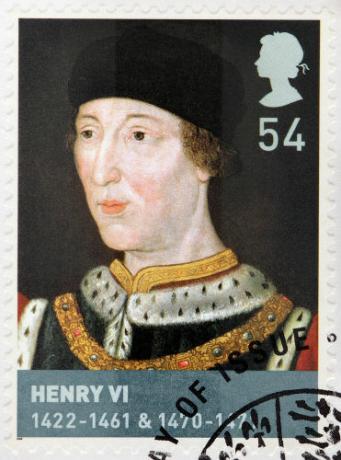THE War of the Roses it was a civil war that divided England in the mid-fifteenth century. This war took place between 1455 and 1485 and placed York and Lancaster – two noble families – in the dispute for the English throne. This war ensured the rise of Henry Tudor who, crowned Henry VII, initiated the Tudor dynasty.
Also access: Discover the story responsible for the rise of the Avis dynasty in Portugal
Why is this war called the War of the Roses?
The War of the Roses takes its name from the symbols of the two families that were in dispute for the English throne. The Lancasters had as a symbol a Red rose and the Yorks had as a symbol a pinkWhite. When Tudor came to power in 1485, the symbol of the two families was merged as a way to demonstrate the union of the Lancaster and York families, and thus came the Tudor Rose.
historical background
The War of the Roses was a conflict between two noble families in England, both believing they had the right to assume the country's throne. The roots of this conflict go back to the end of the 14th century and to the succession problems that arose during the Plantagenet dynasty. These problems, particularly, refer to the reign of Ricardo II, King of England, between 1377 and 1399.
In 1377, Edward III died and the succession to the throne went to Richard II, who was his grandson, as the eldest son of Edward III, named Edward the Black Prince died and Richard, being Edward's eldest son, was eventually crowned King of England as Ricardo II. The coronation of Richard II created some uncertainty about the succession to the English throne.
This is due to the fact that Richard II took the throne when he was only 10 years old and, as he had no descendants, the succession to the throne remained uncertain. Furthermore, the reign of Richard II was becoming unpopular, which agitated his closest relatives, especially the heirs of John of Ghent and Edmund of Langley, the founders of the Lancaster and York families, respectively.
Lancaster Dynasty
The Plantagenet dynasty and the succession to the English throne were interrupted when Ricardo II was deposed from power through a coup organized by members of the Lancasters – led by Henry IV. This coup took place in 1399 and gave rise to new power struggles in later decades, especially during the reign of Henry VI.
The Lancaster's rise to power is directly related to Henry of Bolingbroke, son of John of Ghent and cousin of Richard II. The English King and Henry went on a collision course and Richard II decreed Henry's banishment. Later, the king took over Henry's inheritance after the death of John of Ghent (Henry's father).
Henry of Bolingbroke then joined forces and returned to England to start a campaign military against the king on the grounds that he wanted to regain his rights as Duke of Lancaster. This campaign, however, gained momentum and resulted in the king's deposition in 1399 and started the Lancaster dynasty.
reign of Henry VI

Henry VI was considered a weak king and this motivated Richard, Duke of York, to aspire to the English throne.*
After the Lancasters came to power through the coup in 1399, the kings of England were Henry IV (1399-1413), Henry V (1413-1422) and Henry VI (1422-1461). The big problems that started the War of the Roses occurred during the reign of Henry VI.
This last king did not have much support in the English nobility and was seen as a king. weak and Crazy. Henry VI was considered weak, as it was during his reign that England definitively lost the Hundred Years War, which deeply displeased the English nobility. In addition, Henry VI had psychiatric problems – schizophrenia and/or depression is speculated – which gave him the nickname of mad.
Henry VI's inability to govern caused Ricardo, Duke of York, assume as Lordprotector of England between 1454 and 1455, but after the king's recovery Richard, Duke of York, refused to return power to Henry VI. This started a conflict between the King and the Lord Protector and this factor was what caused the start of the War of the Roses.
Also access: Was the Middle Ages really the Dark Ages?
War of the Roses
The War of the Roses officially began with the Battle of Saint Albans, in May 1455. In this battle, the forces of Henry VI faced the forces of Richard, Duke of York and the fight took place at Saint Albans. Richard's rise as the king's opponent is directly related to his ambition to occupy the English throne in place of Henry VI.
The English king's troops were defeated, King Henry VI was taken prisoner, and his wife, Margaret of Anjou, and his son, Edward of Westminster, fled. The English king was forced to recognize Richard, Duke of York, as Lord Protector of England. Disputes between the Lancasters and the Yorks, however, continued in the following years.
Countless new battles took place as Bloreheath, Ludford and Northampton. THE Battle of Wakefield, which took place in December 1460, was marked as an obvious victory for the Lancasters. In this battle, Ricardo, Duke of York, was eventually killed, but the dispute between the York and the Lancasters continued.
Deposition of Henry VI
After the death of Richard, Duke of York, his son Edward became Duke of York and continued the fight against the Lancasters. New battles took place in Mortimer's Cross and saintAlbans. With the help of the Earl of Warwick, Edward managed to regain his strength and fought the Lancasters in the Towton Battle.
The York won the battle and forced the king, his wife and son to flee to Scotland. Edward, victorious, was crowned King of England and became Edward IV. Lancaster resistance extended until 1464 and Henry VI was captured in 1465, again becoming a prisoner of York.
reign of Edward IV

Edward IV, son of Richard, Duke of York, became King of England in 1461.*
The accession to the throne of England was due in large part to the efforts of the Nevilles, especially the Earl of Warwick, called Ricardoneville. The Earl of Warwick began negotiations with the French royal family for Edward IV to marry the daughter of King Louis XI. King Edward IV, however, had other plans for himself and secretly married Elizabeth Woodville, daughter of a gentry family.
The king's secret marriage infuriated the Earl of Warwick, in that while he was negotiating with the French king, Edward IV was married and because the king's marriage to the Woodvilles marked the rise of that family in the nobility English. So, progressively, the Earl of Warwick moved away from the king.
Warwick's departure from the king made him allies with the Lancasters in 1469, and with that he was even able to convince the king's brother – Jorge Plantagenet – to ally with the Lancasters. The following year, in 1470, Warwick led a military force that invaded England, defeated Edward IV, forcing him to flee, and then restored Henry VI on the English throne.
Edward IV took refuge in Burgundy and had the support of his brother-in-law, Carlos, Duke of Burgundy. Edward IV then returned to England and regained the throne making Henry VI his prisoner once again. With the restoration of Edward IV new battles followed. In April 1471, at the Battle of Barnet, the Earl of Warwick was killed and in May 1471, the York defeated the Lancasters definitively at the Battle of Tewkesbury.
During these events, Henry VI's son Edward of Westminster died in battle and Henry VI ended up being executed by order of Edward IV.
Also access: Understand how the economy works in medieval Europe
How did the War of the Two Roses end?

Richard III usurped the throne from the heir of Edward IV and was King of England between 1483 and 1485.*
After the victory at Tewkesbury, Edward IV reigned over England until 1483. That year, Edward IV died for unknown reasons and the succession was passed on to his son, who became known as Edward V. turns out that Richard, Duke of Gloucester, was appointed as Lord Protector because Edward was a child.
The Duke of Gloucester, however, turned on his nephew, imprisoned him with his brother, and secured a declaration that the marriage of Edward IV and his children was illegitimate. Thus, the Duke of Gloucester ascended the throne as Ricardo III, in 1483. Some time later, the two sons of Edward IV mysteriously disappeared and it is suspected that they were murdered at the behest of Richard III.

Henry Tudor, defeated Richard III at the Battle of Bosworth Field and became Henry VII.*
During the reign of Richard III, the name of Henry Tudor, descendant of Lancasters, began to be broadcast as an alternative to assume the English throne. Henry Tudor gathered forces and led an invasion of England in 1485. At Battle of Bosworth Field, Richard III was killed and Henry Tudor ascended the English throne, being crowned Henry VII.
With the Tudor victory, the York dynasty lost power and the Lancasters again assumed the throne in England. To end the conflicts between the families, Henry VII married Elizabeth of York, daughter of Eduardo IV, and this marked the beginning of Tudor dynasty.
*Image credits: Sergey Goryachev and Shutterstock

